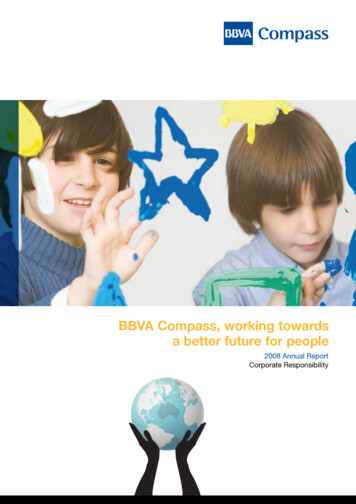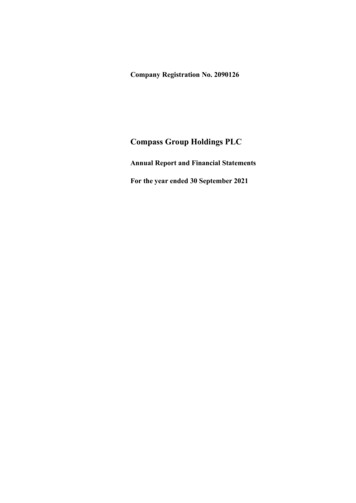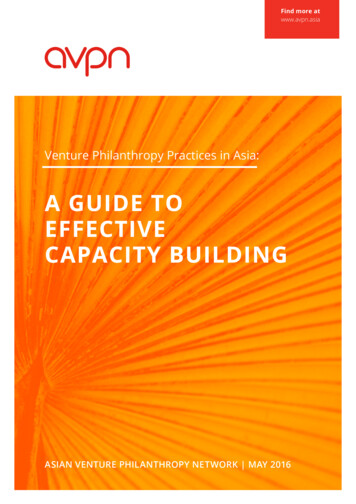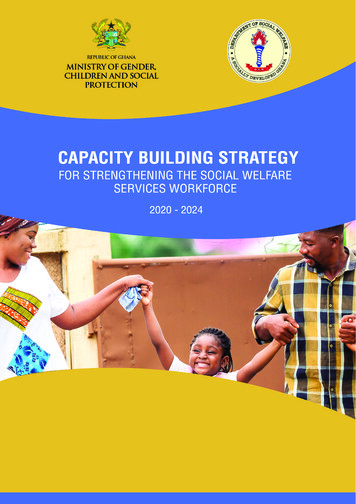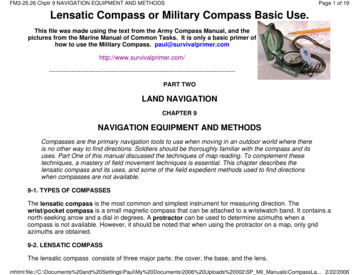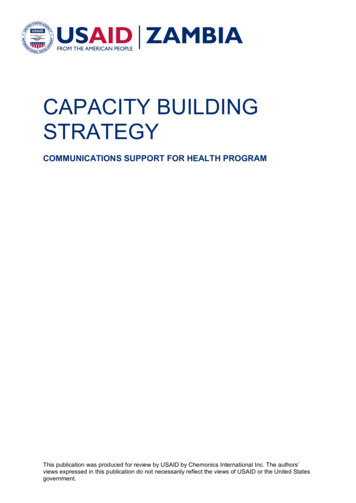
Transcription
CAPACITY BUILDINGSTRATEGYCOMMUNICATIONS SUPPORT FOR HEALTH PROGRAMThis publication was produced for review by USAID by Chemonics International Inc. The authors’views expressed in this publication do not necessarily reflect the views of USAID or the United Statesgovernment.
INTRODUCTIONThe Communications Support for Health (CSH) program aims to enhance the capacity of theGovernment of the Republic of Zambia (GRZ) to manage and implement effective nationalhealth communications interventions. It is expected that enhanced IEC/BCC management ofthe GRZ will translate into changes in population health related behaviors. This change isexpected to result in a measurable reduction in the practice of risky behaviors, and increaseddemand for and use of health care services. The vision of the CSH program is to have anempowered Zambian population that is able to make informed health decisions and lifestylechoices. The CSH project has four objectives: Strengthen national health communications campaignsIncrease the GRZ’s use of evidence-based health communication approachesStrengthen local capacity to support sustained implementation of IEC/BCC activitiesCoordinate IEC/BCC activities among USAID projectsTo achieve these objectives, the CSH team is implementing a multi-pronged capacitybuilding strategy that involves strengthening individuals’ performance, organizationalstructures, and national strategies.Capacity building efforts implemented by the CSH program focus on building partnerships;developing national guidelines, communication strategies and training manuals and guides;issuing and managing grants; training and orientation; and mentorship and coaching.Capacity building is a crosscutting activity that underpins all elements of the program.Definition of Capacity BuildingAlthough there are a variety of definitions for capacity building, perhaps the mostfundamental is “actions that improve an individual or organization’s effectiveness.” Otherdiscussions about capacity building refer to the concept as “actions that enhance anorganization’s ability to work towards its goal.”CSH uses short-term, medium-term, and long-term capacity building interventions to addressissues of sustainability beyond the program’s implementation period.SHORT TERM Sensitization workshopsIn-house/onsite trainingExchange visitsSite visits/monitoringGap analysisDevelopment of capacitybuilding plansMEDIUM TERM Embedded staff atMinistry of Health,National Malaria ControlCentre, and NationalAIDS CouncilTrainingGap analysisMentorship and learningby-doingLONG TERM Production and disseminationof training toolkits andmanualsProduction and disseminationof national communicationstrategies and guidelinesNetworking and partnershipsResearch and disseminationof findings (baselines,formative research)Documentation of lessonsand success storiesRefresher and retrainingCapacity Building Strategy: USAID/Zambia Communications Support for Health Program2
The ProcessCSH follows a five-step process.1. Stakeholder EngagementAt every stage of CSH activities, the program team engages GRZ and key partners andencourages them to be fully involved in the process, whether it is development of acampaign, creation of a training toolkit, or research. The purpose is to achieve a high level ofownership and motivation on the part of GRZ.2. Capacity Assessment/Identification of Gaps/NeedsAt the beginning of the program, the team conducted capacity assessments to ascertainstrengths and gaps in development and implementation of IEC/BCC activities and campaigns.Capacity assessments were conducted for other areas such as monitoring and evaluation,research, and systems.3. Formulation of Capacity Building PlansCapacity building plans are informed by findings from the capacity assessments, andrepresent both short-term and long-term planning. (The grants to Afya Mzuri and CHAMPare long-term capacity building strategies.)4. Implementation of Capacity Building PlansDifferent interventions are planned respond to the needs identified during the capacityassessments. This is an ongoing process that includes identification of emerging needs andadditional gaps and adjusting the plans to incorporate the new findings. (For example, theinitial capacity building plan targeted national-level GRZ staff; later, a need was identified toinclude provincial-level staff members who are directly responsible for implementation.5. Monitoring and Evaluation of Capacity Building PlansThe CSH team has developed tools and frameworks to monitor all campaigns and training.Monitoring is a continuous process, carried out through field monitoring and review ofactivity reports.Capacity Building Strategy: USAID/Zambia Communications Support for Health Program3
CONCEPTUAL FRAMEWORKImproved ow Howto Do ItOpportunityto N, TRAINING, AND MENTORSHIPCAPACITY BUILDING PLANS ANDPARTNERSHIPSCapacity Assessments/Gap IdentificationCapacity Building Strategy: USAID/Zambia Communications Support for Health Program4Researchand M&E
CHALLENGES/CONSTRAINTS1. Limited participation in capacity building activities by national-level GRZ staff hasresulted in weak ownership of some interventions (for example, most campaigns areimplemented directly by CSH through other partners and CSOs).2. Limited human resources coupled with staff turnover. Some staff members trained byCSH have moved on to other organizations, leaving a gap in skills and knowledgerequired for effective BCC programming3. Challenges related to motivation of staff to embrace the CSH program’s approaches dueto demands beyond what CSH is able to offer.Addressing Challenges and Constraints FlexibilityCreativityOngoing communicationWorking togetherMore opportunities for practiceRefresher/retrainingPublic-private partnershipsCapacity Building Strategy: USAID/Zambia Communications Support for Health Program5
Capacity building efforts implemented by the CSH program focus on building partnerships; developing national guidelines, communication strategies and training manuals and guides; issuing and managing grants; training and orientation; and mentorship and coaching. Capacity building is a crosscutting activity that underpins all elements of the .




